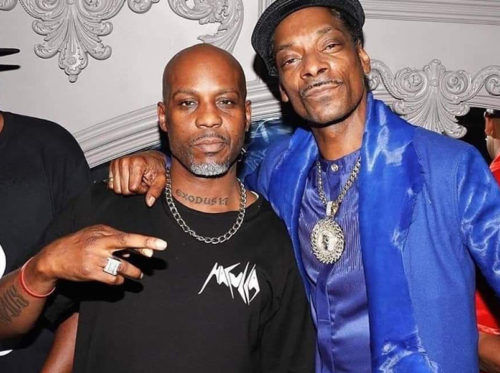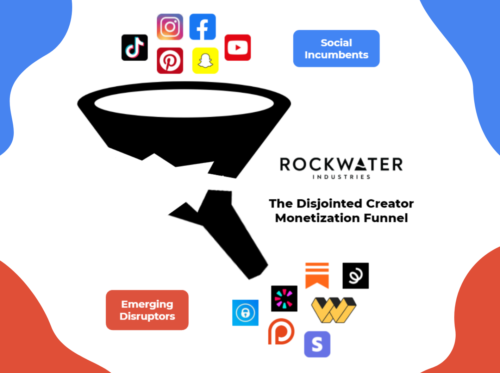The Future of Creator Funds and Tools
The RockWater Roundup: Podcast Episode Notes and Listener Links
Social platforms are investing big money into creator funds and products. Like LinkedIn ($25 million), Facebook and Instagram ($1B), YouTube Shorts ($100M), Snap ($1M per day), Only Fans (£80K), and the list goes on. The platforms are also aggresively launching new creator tools ranging from social / livestream commerce and live audio to self-publishing, fan payments, and subscriptions.
Chris and Andrew explain why, and how this trend could evolve into program pullbacks and creator illwill, investment in creator-owned businesses, different incentive structures for different content types, and more.
Subscribe to our newsletter. We explore the intersection of media, technology, and commerce: sign-up link
Learn more about our market research and executive advisory: RockWater website
Email us: rounduppod@wearerockwater.com
You can listen, subscribe, and follow our show on:
Our ask: wherever you listen, and particularly on Apple Podcasts, please give us a rating and write a short review. And forward to a friend. Doing so will help others discover the RockWater Roundup.
EPISODE TRANSCRIPT:
Chris Erwin:
So Andrew it’s time for another Roundup podcast. But before we talk about the topic of this week, which is creator funds, just a quick explainer to the audience we have been off for about a month since we last published. We took a little break at the end of August and through Labor Day. We think it’s helpful to refresh and energize. I was off surfing in Portugal. And then was at my brother’s wedding in Texas. What were you doing Andrew?
Andrew Cohen:
On a wedding tour as well.
Chris Erwin:
Hopefully we’re coming back with a Roundup that’s going to be better and stronger, version 2.0.
Andrew Cohen:
Yes. Feeling well rested. Hopefully it’s rest, not rust.
Chris Erwin:
I’ve never heard that before, but I like it. All right. So let’s talk about creator funds. So what’s happening? Platforms are investing big money into different creator funds and initiatives, really to keep creators on the platform. Right? So some news like LinkedIn over the past couple of weeks launched a 25 million dollar creator fund. Facebook and Instagram have announced that they want to pay out over a billion dollars to creators. Snap has their spotlight program initially a million dollar per day, but pulling back on that, talk about that in a sec. YouTube has a shorts fund for 100 million, and then there is a long laundry list. They’re Square, and Linktree, SoundCloud, Pinterest, OnlyFans, Twitter, and a bunch more. But clearly Andrew, a lot of activity in the space to try and get creators excited, right?
Andrew Cohen:
The formula is simple. Creators bring audience and audience brings revenue. So the way it used to work was that these incoming platforms, they would offer a really broad reach and that they would monetize creators and publishers audiences via advertising by connecting marketers with the customers. And creators and publishers, they would make revenue through a piece of the advertising on the social platform, but really the real outsize revenue and big enterprise value would come through monetizing their fandom off a platform through merge, through product licensing, through upstream TV and film sales, subscriptions, everything else. So really it would be social media is kind of the top funnel for audience reach and engagement and the bottom funnel would happen elsewhere where the creators would make the real money, but it started to change.
Andrew Cohen:
So first, emerging creator economy platforms as we’ll call them, things like Substack, Patreon, OnlyFans, Cameo, they began offering more ways for creators to monetize their fans. And so creators and fans then started spending more time on those platforms. So quick lists, Substack has 500,000 paid subscribers and their top writers make over a million dollars annually. Patreon has 200,000 traders on their platform and they pay out over a billion a year to its creator community. OnlyFans had 85 million users. And last year in 2020 paid over a billion dollars to its creators.
Chris Erwin:
Andrew, I just have to pause you on OnlyFans. I can’t believe 85 million users. Like that’s huge. And a question. I don’t know if you know this, but in the past couple of months OnlyFans, weren’t going to cater to sex workers or sexually explicit content. Do you know if that user count fell since then?
Andrew Cohen:
I’m not sure. Because they did kind of do away with that decision almost within a week of making it. So I’m not sure if there was even long enough for a backlash to really manifest in user count.
Chris Erwin:
Sorry, tangent, but go ahead.
Andrew Cohen:
All good. Numbers made me step back as well. And so finally Cameo last year in 2020 had 100,000 new creators showing the platform and paid out 75 million to its creators in 2020. Yeah. So because of that, creators started spending more time on those platforms and their audiences did too. Secondly, platforms started to realize that how much revenue they’re missing out on by only providing this top of funnel because outside of these immersion creator economy platform, there’s a lot of top publishers and creators were using social platforms to build an audience and then they monetize elsewhere. So for example, Parcelforce said that this year that they’re making 200 million in revenue in 2021. I bet social media is a huge part of their audience development strategy, yet a very minor piece of their revenue strategy.
Andrew Cohen:
MrBeast, remember MrBeast Burger last year, which has a projected revenue potential of 300 million. His whole audience comes off of YouTube. And finally Ryan’s World last year in 2020 made 30 million in consumer products, which was more money than he generated off of YouTube ad. So I think between those two things, social media platforms saw that they’ve got some work to do to keep creator community and then their fan community on the platform and keep them happy.
Chris Erwin:
Andrew, based on all of that, I think now what we’re seeing is that these incumbent platforms, they really want to better cater to creators. They don’t want to just be like the top of funnel solution and distribution platform for their content, but really the ability to be an end to end funnel where they can allow creators to really engage more deeply with their fans, develop new monetization and revenue relationships, and really drive more time on platform for both audiences and publishers. So there’s a few themes from these different product driven initiatives that we’ve seen platforms like Facebook, and YouTube, and Twitter do. And look, we really saw a spike in these product announcements from the end of 2022 to the first quarter of this year in 2021. And look, new announcements continue to persist up until today, but there was really that spike period during that six month window.
Chris Erwin:
And I think what we saw is that a lot of the incoming platforms were getting inspiration from some of these new emergence and upstarts and even their peers just brought it on and be like, well, where can we be a fast follower? What can we replicate? Right. That’s a whole same classic argument of Instagram stories copying what Snapchat was doing back in the day. And I think the question that we have that’s outstanding is which of these product initiatives are going to be experiments and are probably going to fall by the wayside? And what’s really going to have staying power? What’s going to really move the needle for creators and really delight their fans? And what’s going to stick? We don’t know, but it’s definitely worth tracking. So there’s, I think around four or five product themes that we’ve seen. One when Clubhouse came out with live audio, and everyone’s talking about that being the next consumer frontier, just saw Twitter launch Spaces, Facebook get into the audio game and LinkedIn even do the same.
Chris Erwin:
And then when you saw OnlyFans and Patreon enabling direct to consumer monetization and like a tip jar, you saw Facebook fan payments, subscriptions, offering the ability to charge for live events. And then Twitter getting into super follows, allowing exclusive tweets and content. Right. Then there was a whole explosion of newsletters and the whole Substack revolution. Twitter this year, earlier this year bought Revue, a self publishing platform, Facebook even gotten to the self publishing platform again as well. And then e-commerce and live stream commerce. That was really exciting. You saw Popshop raise at a big valuation earlier this year, Whatnot did the same. So a lot of these platforms were like, oh, how can we get in the live shopping game as well? So Facebook and YouTube started innovating on some of their live shopping products. I think more is in the mix. TikTok has a Shopify partnership and then YouTube is even selling digital goods through a new partnership with Spring. That’s a short list. There’s likely many more after that. But I think the big question Andrew is, how is all of this going to evolve?
Andrew Cohen:
I’m really interested to see. I think what’s fun about this is that no one knows for sure. There’s so much competition and so much capital out there that we’re all kind of building it and learning to fly the plane as we’re building it. So I think like you said, there’s already been some pullback, but I think that the structure and incentive of these funds and of these creator initiatives I think are going to continue to evolve in different ways. I think one thing that’s really exciting to me is maybe the potential of these funds and platforms investing in creator owned business. So we’ve already seen VC Funds owned by creators like Josh Richardson and Mr. Beast launched two investing creator businesses. We saw Triller buy Verzuz. So could there be any more investments like that where platforms can tap into the true enterprise value creation and enable and empower custom integrations that can really grow creator businesses in unique ways, kind of more of a white glove approach than what we’ve seen so far.
Chris Erwin:
Platforms like Snap have launched incubators or accelerators for companies that are building tools that really power the snap ecosystem. I think the question is operationally, is this going to require the platforms to have like different fund structures, different dedicated teams to do this right? I would probably say yes and see what happens. I think another point Andrew is that, are we going to see different creator incentive structures for different types of content, right? Promoting long form versus short form, video versus audio versus text, right? Macro versus micro creators. And I think this stems from just talking to a few executives at companies like Facebook and YouTube, like there’s a real concern about the explosion of TikTok viewership for short form content. So that’s why YouTube launched it’s 100 million dollar program for shorts, right? Realizing that they don’t want to fall too behind the eight ball there. And they really want to go to where the eyeballs are headed.
Chris Erwin:
But yeah, I would say don’t be surprised when TikTok, as they’re really building out their short form audience, they’re starting to move into longer form content, right? They just had an announcement a few months ago, having videos go from 30 seconds to three minutes. What’s next five minutes, 10 minutes, like longer form? And is TikTok going to start thinking about a creator program that incentivize that longer form engagement for them? I don’t know.
Andrew Cohen:
And it probably won’t be a one size fits all solution. What works for Substack in text is going to be different than what works for Roblox and their creator programs and the meta verse, could be different from what TikTok is doing in short form and YouTube in long form. So I think it’s going to be really interesting to see how it all comes together in kind of custom ways based on the needs of each platform and it’s creator community.
Chris Erwin:
Final point here, Andrew, before we wrap up is yeah, I think a lot of these platforms really start needing to think about what are their KPIs for measuring ROI, right? Is it user acquisition, engagement, retention, is it time on platform? What is it? Look, I think back to the early days when I got into digital media at Big Frame and Awesomeness, and it was initially, like we were building for comScore numbers. So just be able to raise our next investment round and then realize that we have to have a sustainable P&L and business model. And we got to start driving towards revenue and profit. So I think that everyone, all these platforms are looking around and saying, all right, like you said, Andrew creators bring audience and they bring revenue and advertisers.
Chris Erwin:
So now everyone’s launched these creator programs and people were like, well, we don’t want to get left out. We want to have like a big press release. We want to show we’re committed to this. But I think there’s a chance that if you don’t do this right, and you don’t know what you’re working towards, there’s going to be some big fallout. And you’re going to have a pullback of these programs that aren’t getting the ROI that they need. Leadership’s going to start like turning the screws on some of their lieutenants. This is already is starting to happen, right? Like Clubhouse over the past couple of weeks, some press about them not delivering on talent deals, not bringing the revenue, the sponsorships, the marketing support that a lot of these Clubhouse creators wanted.
Chris Erwin:
And then even Snapchat came out and said that I think they’re taking Spotlight. And instead of having that be a million dollars a day, they’re rethinking how they spread out that revenue and that program like throughout the month. I think there was concerns about seeing a lack of content innovation. A lot of just like me too formats that followed the most recent trend and they want to see something different. So that can also cause a lot of ill will with the creator community. So I’m curious to see what happens there.
Andrew Cohen:
Throwing a couple of million or billion at a problem doesn’t necessarily give you the solution that you’re looking for. So I think all of these funds are going to be refined over time.
Chris Erwin:
So Andrew, I think we are at the end of our time here. Think as we always say, till next time.
Andrew Cohen:
Hopefully that wasn’t too rusty.
—
Ping us here at anytime. We love to hear from our readers.



